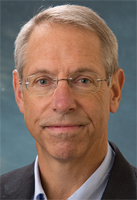Where Oncology Drug Discovery Goes Next

By Matthew Pillar, Editor, Bioprocess Online

This article originally appeared in Life Science Leader magazine
Steve Davidsen, Ph.D., joined then-Abbott Labs (now AbbVie) in 1986, fresh on the heels of completing his postdoctoral work at U.C. Berkeley. Thirty-seven years later he’s still there, serving the company as Bay Area Site Head and VP of Oncology Discovery Research.
In biotech, that kind of longevity in a single company is rare. The perspective it’s afforded him is equally unique. As drug research and discovery go, AbbVie was modality-agnostic before it was cool. Davidsen counts himself as a beneficiary of that approach. It’s provided him a holistic view of modern cancer treatment and a strong opinion on where it must go next.
DISCOVERY PACE, PERSONALIZED MEDICINE: THE WAY FORWARD

“Because cancer is a very heterogeneous set of diseases, the toolbox needs to be big, so that we can choose the most appropriate tool for the underlying biology,” he says. At AbbVie, the Precision Medicine Group bears that responsibility. Its goal is to identify which tumor types are optimal for a given mechanism or molecule, which patients within those tumor types are optimal to treat, and whether the molecule is behaving in a cancer patient as designed.
On the discovery side, Davidsen again points to advanced toolsets, this time on the computational front. He says AbbVie is interrogating the genomes of thousands of highly curated, clinically linked patient tumor samples to understand the relationship between target expression and sensitivity to a given mechanism or molecule. His team also uses artificial intelligence for the de novo design of drugs, enabling quick transition from the structure of a protein or target to lead molecules that bind to it. Machine learning platforms, he says, are increasingly capable in their ability to predict the drug-like properties of those lead molecules, even before they’re physically synthesized. “These tools weren’t even imaginable when I got started. They’re still evolving, but they’re clearly contributing to our drug discovery efforts,” he says.
UP TO THE RAFTERS IN MOLECULAR DISCOVERY
As patient-specific data and the computational tools necessary to decode that data accelerate drug discovery at AbbVie, the company might find itself looking for some additional ceiling space. When he took the VP position at AbbVie, Davidsen launched a tradition called the “Molecule Hanging Ceremony” to acknowledge his team’s contribution to the company’s new drug efforts. A model of every molecule that makes its way through GLP (Good Laboratory Practice) toxicity studies to ultimately be dosed in a cancer patient is crafted from stainless steel. Those models are hung from the ceiling of AbbVie’s Cancer Research Suite during a celebratory ceremony. To date, the team has suspended some 40 molecules. “The large molecules could consume the entire space, so we model just the first five amino acids on the n-terminus of the antibodies,” Davidsen explains. “We wouldn’t want a single antibody to consume all the space that these small molecules have been enjoying, and some of them would probably pull down the rafters.”
Learn more about Dr. Davidsen’s long and illustrious tenure at AbbVie on episode 118 of the Business of Biotech podcast.
